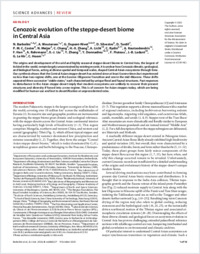Cenozoic evolution of the steppe-desert biome in Central Asia
- Barbolini, N. Department of Ecosystem and Landscape Dynamics, Institute for Biodiversity and Ecosystem Dynamics, University of Amsterdam, 1098 XH Amsterdam, Netherlands. - Department of Ecology, Environment and Plant Sciences and Bolin Centre for Climate Research, Stockholm University, SE-106 91 Stockholm, Sweden.
- Woutersen, A. Department of Ecosystem and Landscape Dynamics, Institute for Biodiversity and Ecosystem Dynamics, University of Amsterdam, 1098 XH Amsterdam, Netherlands.
- Dupont-Nivet, G. Universität Potsdam, Institute of Geosciences, 14476 Potsdam, Germany. - Université de Rennes, CNRS, Géosciences Rennes–UMR 6118, F-35000 Rennes, France. - Key Laboratory of Orogenic Belts and Crustal Evolution, Peking University, Beijing 100871, China.
- Silvestro, Daniele Department of Biology, University of Fribourg, Ch. De Musée 10, Fribourg, Switzerland.
- Tardif, D. Institut de Physique du Globe, Paris 75005, France.
- Coster, P. M. C. Biodiversity Institute, University of Kansas, Lawrence, KS 66045, USA.
- Meijer, N. Universität Potsdam, Institute of Geosciences, 14476 Potsdam, Germany.
- Chang, C. Key Laboratory of Biogeography and Bioresource in Arid Land, Xinjiang Institute of Ecology and Geography, Chinese Academy of Sciences, Urumqi 830011, China.
- Zhang, H.-X. Key Laboratory of Biogeography and Bioresource in Arid Land, Xinjiang Institute of Ecology and Geography, Chinese Academy of Sciences, Urumqi 830011, China.
- Licht, A. Department of Earth and Space Sciences, University of Washington, Seattle, WA 98195, USA.
- Rydin, C. Department of Ecology, Environment and Plant Sciences and Bolin Centre for Climate Research, Stockholm University, SE-106 91 Stockholm, Sweden. - The Bergius Foundation, The Royal Swedish Academy of Sciences, Box 50005, SE-104 05 Stockholm, Sweden.
- Koutsodendris, A. Institute of Earth Sciences, Heidelberg University, Heidelberg 69120, Germany.
- Han, F. School of Earth Sciences, East China University of Technology, Nanchang 330013, Jiangxi, China.
- Rohrmann, A. Universität Potsdam, Institute of Geosciences, 14476 Potsdam, Germany.
- Liu, X.-J. College of Geography and Environmental Science, Northwest Normal University, Lanzhou 730070, China.
- Zhang, Y. The First Monitoring and Application Center, China Earthquake Administration, Tianjin 300180, China.
- Donnadieu, Y. Laboratoire des Sciences du Climat et de l’Environnement (LSCE)/Institute Pierre Simon Laplace (IPSL), Commissariat á l’Énergie Atomique et aux Énergies Alternatives (CEA)-CNRS–Université de Versailles Saint Quentin-en-Yvelines (UVSQ), Université Paris-Saclay, Gif-sur-Yvette, France. - Aix-Marseille Université, CNRS, Institut pour la Recherche et le Développement (IRD), Collège de France, Centre de Recherche et d’Enseignement de Géosciences de l’Environnement (CEREGE), Aix-en-Provence, France.
- Fluteau, F. Institut de Physique du Globe, Paris 75005, France.
- Ladant, J.-B. Department of Earth and Environmental Sciences, University of Michigan, Ann Arbor, MI 48109, USA.
- Le Hir, G. Institut de Physique du Globe, Paris 75005, France.
- Hoorn, C. Department of Ecosystem and Landscape Dynamics, Institute for Biodiversity and Ecosystem Dynamics, University of Amsterdam, 1098 XH Amsterdam, Netherlands.
-
20.08.2020
Published in:
- Science Advances. - 2020, vol. 6, no. 41, p. eabb8227
English
The origins and development of the arid and highly seasonal steppe-desert biome in Central Asia, the largest of its kind in the world, remain largely unconstrained by existing records. It is unclear how Cenozoic climatic, geological, and biological forces, acting at diverse spatial and temporal scales, shaped Central Asian ecosystems through time. Our synthesis shows that the Central Asian steppe-desert has existed since at least Eocene times but experienced no less than two regime shifts, one at the Eocene–Oligocene Transition and one in the mid-Miocene. These shifts separated three successive “stable states,” each characterized by unique floral and faunal structures. Past responses to disturbance in the Asian steppe-desert imply that modern ecosystems are unlikely to recover their present structures and diversity if forced into a new regime. This is of concern for Asian steppes today, which are being modified for human use and lost to desertification at unprecedented rates.
- Faculty
- Faculté des sciences et de médecine
- Department
- Département de Biologie
- Language
-
- English
- Classification
- Biological sciences
- License
-
License undefined
- Identifiers
-
- RERO DOC 329617
- DOI 10.1126/sciadv.abb8227
- Persistent URL
- https://folia.unifr.ch/unifr/documents/309074
Statistics
Document views: 178
File downloads:
- pdf: 303
